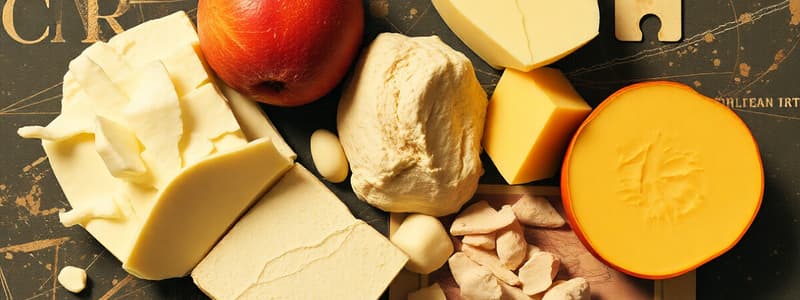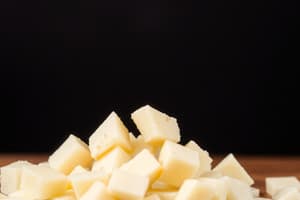Podcast
Questions and Answers
Which type of fatty acid contains a carbon chain with only single bonds?
Which type of fatty acid contains a carbon chain with only single bonds?
- Trans fatty acids
- Saturated fatty acids (correct)
- Polyunsaturated fatty acids
- Monounsaturated fatty acids
What is the primary source of monounsaturated fatty acids?
What is the primary source of monounsaturated fatty acids?
- Coconut oil
- Butter
- Peanut oil (correct)
- Lard
Which fatty acid is classified as a medium-chain fatty acid?
Which fatty acid is classified as a medium-chain fatty acid?
- Stearic acid
- Palmitic acid
- Caprylic acid (correct)
- Butyric acid
Trans fatty acids are mainly found in which type of food products?
Trans fatty acids are mainly found in which type of food products?
Which of the following fatty acids is primarily found in palm oil?
Which of the following fatty acids is primarily found in palm oil?
What role does cholesterol serve in animal cells?
What role does cholesterol serve in animal cells?
Which of the following statements about cholesterol is true?
Which of the following statements about cholesterol is true?
Which lipoprotein is categorized as 'high-density'?
Which lipoprotein is categorized as 'high-density'?
Which of the following is synthesized from cholesterol?
Which of the following is synthesized from cholesterol?
In which of the following compounds is cholesterol not typically found?
In which of the following compounds is cholesterol not typically found?
What is the formula for Oleic acid?
What is the formula for Oleic acid?
Which fatty acid contains three double bonds?
Which fatty acid contains three double bonds?
Which of the following fatty acids is classified as a hydroxy fatty acid?
Which of the following fatty acids is classified as a hydroxy fatty acid?
How many double bonds are present in Arachidonic acid?
How many double bonds are present in Arachidonic acid?
Which fatty acid is considered a polyunsaturated fatty acid (PUFA)?
Which fatty acid is considered a polyunsaturated fatty acid (PUFA)?
What characterizes a triglyceride?
What characterizes a triglyceride?
Which of the following requires the most hydrogen atoms in its hydrocarbon chain?
Which of the following requires the most hydrogen atoms in its hydrocarbon chain?
What indicates that a triglyceride is classified as an oil rather than a fat?
What indicates that a triglyceride is classified as an oil rather than a fat?
What characteristic distinguishes omega-3 fatty acids from omega-6 fatty acids?
What characteristic distinguishes omega-3 fatty acids from omega-6 fatty acids?
Which of the following is a source of omega-3 fatty acids?
Which of the following is a source of omega-3 fatty acids?
Which statement about omega-6 fatty acids is incorrect?
Which statement about omega-6 fatty acids is incorrect?
What happens to omega-3 fatty acids when exposed to heat, light, and oxygen?
What happens to omega-3 fatty acids when exposed to heat, light, and oxygen?
Which fatty acid is known for being an important component of brain membranes?
Which fatty acid is known for being an important component of brain membranes?
What is one function of omega-3 fatty acids in human health?
What is one function of omega-3 fatty acids in human health?
What is the name given to the hormone-like compounds made from both omega-3 and omega-6 fatty acids?
What is the name given to the hormone-like compounds made from both omega-3 and omega-6 fatty acids?
Which of the following structural formulas represents linolenic acid?
Which of the following structural formulas represents linolenic acid?
Which component is NOT found in glycerophospholipids?
Which component is NOT found in glycerophospholipids?
What is the primary function of sphingomyelin in cells?
What is the primary function of sphingomyelin in cells?
Which substance is a glycolipid?
Which substance is a glycolipid?
Which statement about steroids is accurate?
Which statement about steroids is accurate?
Which option is a nitrogen base commonly found in lecithin?
Which option is a nitrogen base commonly found in lecithin?
Where is cholesterol most abundantly located in the body?
Where is cholesterol most abundantly located in the body?
Which lipids are composed of glycerol and two fatty acids?
Which lipids are composed of glycerol and two fatty acids?
Galactocerebrosides are primarily found in which part of the body?
Galactocerebrosides are primarily found in which part of the body?
Flashcards are hidden until you start studying
Study Notes
Fatty Acids Classification
- Short-chain fatty acids (SCFA): C4 to C6
- Medium-chain fatty acids (MCFA): C8 to C10
- Saturated fatty acids (SFA): Carbon chain with all single bonds.
- Unsaturated fatty acids (UFA): Carbon chain containing one or more double bonds.
- Monounsaturated fatty acids (MUFA): One double bond, found in peanuts, olive oil, avocado.
- Polyunsaturated fatty acids (PUFA): Two or more double bonds, found in corn oil, fish oils.
Sources and Types of Saturated Fats
- Saturated fats primarily sourced from:
- Animal fats: butter, beef tallow, lard, dairy products, egg yolk.
- Coconut oil contains medium-chain saturated fatty acids.
- Trans fats: Naturally found in small amounts in meat and dairy; primarily from processed foods like margarine and pastries.
Key Saturated Fatty Acids
- Butyric acid (C4:0) - Found in butter
- Palmitic acid (C16:0) - Found in palm oil and lard
- Stearic acid (C18:0) - Found in tallow
- Lauric acid (C12:0) - Found in coconut oil
Key Unsaturated Fatty Acids
- Oleic acid (C18:1) - Found in olive oil
- Linoleic acid (C18:2) - Found in corn oil
- EPA (Eicosapentaenoic acid, C20:5) - Omega-3, from fish oils
- DHA (Docosahexaenoic acid, C22:6) - Omega-3, essential for brain function.
Omega Fatty Acids
- Omega-3 fatty acids:
- Linolenic acid (C18:3) - Found in flax seeds and walnuts; lowers triglycerides.
- Omega-6 fatty acids:
- Arachidonic acid (C20:4) - Produced from dietary sources; balances cholesterol levels.
Eicosanoids and Phospholipids
- Eicosanoids: Hormone-like compounds derived from omega fatty acids; important for inflammation and immune responses.
- Phospholipids:
- Glycerophospholipids: Composed of glycerol, fatty acids, and phosphate; essential for cell membranes (e.g., lecithin).
- Sphingomyelin: Contains sphingosine, found in nerve cell membranes.
Steroids
- Steroids consist of a structure with three cyclohexane rings and one cyclopentane ring; function as hormones.
- Cholesterol:
- Most abundant sterol in the body; crucial component of cell membranes.
- Sourced from animal fats; synthesized in the liver.
- Travels in the bloodstream in forms of lipoproteins (LDL, HDL).
Fat-Soluble Vitamins
- Vitamins A, D, E, and K play important roles in various bodily functions and are stored in fatty tissues.
Exercises Overview
- Structural drawing of fatty acids: stearic (C18:0), linoleic (C18:2), oleic (C18:1), arachidonic (C20:4), EPA (C20:5).
- Classification of fatty acids based on saturation: saturated (A), monounsaturated (B), polyunsaturated (C), hydroxy fatty acids (D), cyclic fatty acids (E).
Studying That Suits You
Use AI to generate personalized quizzes and flashcards to suit your learning preferences.




